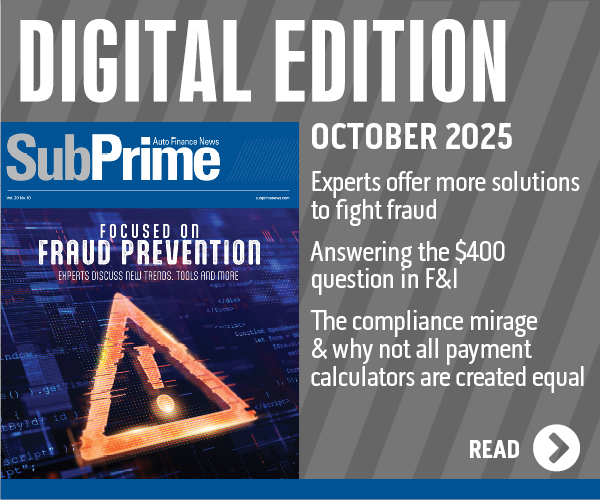DBRS: Auto ABS Performance Outshines Other Investment Segments During Recession
By subscribing, you agree to receive communications from Auto Remarketing and our partners in accordance with our Privacy Policy. We may share your information with select partners and sponsors who may contact you about their products and services. You may unsubscribe at any time.
NEW YORK — Evidently the portfolio assembled by auto lenders during the past five years generated stronger returns for Wall Street investors than other possibilities such as home mortgages.
That's according to the assessment offered by DBRS in its latest report "Auto ABS Performance During the Recession — What Went Right."
Analysts contend that, "While the current economic picture has shown signs of improvement, the overall climate remains relatively fragile.
"While investors in the senior classes of some asset backed securities have suffered losses, investors in auto-backed ABS have remained relatively unscathed," they continued.
During the recession, though performance of auto ABS was somewhat impaired, DBRS emphasized the level of impairment was significantly less than what was experienced in some other asset types such as mortgages.
Analysts calculated the worst performing vintage of auto loans, 2008, experienced cumulative losses that were approximately 1.5 to 2.0 times greater than the best performing vintage. They noted the same situation was not true in the mortgage cohorts where the worst performing vintage experienced average cumulative losses that were seven to eight times worse than the best performing vintage.
Subscribe to Auto Remarketing to stay informed and stay ahead.
By subscribing, you agree to receive communications from Auto Remarketing and our partners in accordance with our Privacy Policy. We may share your information with select partners and sponsors who may contact you about their products and services. You may unsubscribe at any time.
"Thus the structural elements of the auto securitizations were subjected to less stress and were better able to withstand the volatility," DBRS pointed out.
The firm thinks one difference in the performance can be attributed to loss severity.
While loss severities for liquidated mortgages have increased significantly in the past few years, analysts discovered the loss severity experienced on cohort auto pools examined has remained in the range of 38 to 42 percent.
Importance of Used Vehicles to Overall Loan Portfolio Performance
Beyond the ramifications for investors, DBRS also touched on what's important to dealers — especially the broad value of used vehicles.
"As the economy worsens, demand for used cars increases as consumers try to manage their debt load and the lower price of a used car relative to a new one becomes a more attractive option," analysts explained. "Though incentive programs to purchase new cars may reduce some of the increase in demand, most incentives are typically short lived."
To illustrate these points, DBRS cited the Manheim Used Vehicle Value Index, which reached an all-time high reading in May of 127.8.
"While the economy has show signs of improvement, the recovery has shown signs of losing steam, and the unemployment rate remains high," analysts surmised.
"As a result, the relationship between the economy and used car prices is expected to continue to act as a partial natural hedge against poor economic conditions in the near term," they continued.
"Used-car prices will also continue to be supported in the near term as the supply chain for new vehicles continues to struggle with effects of the earthquake and tsunami activity in Japan," analysts went on to say.
As a result, DBRS expects demand, and consequently, prices for used vehicles to remain high for the short term and for loss severities in auto ABS to continue to perform well.
Deeper Justification of Auto ABS Performance
DBRS explained part of the successful track record auto ABS has achieved is attributable to their structure. The firm said auto ABS transactions often employ overcollateralization, fixed reserve account requirements and a sequential pay-down waterfall that de-levers the transaction over time.
"These elements result in increased levels of credit enhancement over the life of the deal," analysts stressed.
"As the asset pool amortizes, the use of a fixed reserve account is beneficial to noteholders in that the reserve account, as measured as a percentage of the asset pool, will tend to increase," they went on to say. "Thus it will be able to withstand greater negative variance in loss expectations than a reserve that amortizes in step with the deal."
DBRS noted the use of overcollateralization has a more subtle but useful benefit to investors in that it boosts the effective excess spread by creating a larger pool of higher yielding assets relative to the lower costing liabilities of the transaction and results in somewhat faster amortization.
"The sequential pay-down of notes is beneficial in that credit enhancement builds over time for the unpaid note, thus enabling the structure to withstand performance shocks," the firm mentioned.
"All of these factors may provide an additional benefit because the increasing robustness of the structure may allow for price appreciation or a rating upgrade for noteholders in the longer dated or subordinated tranches," DBRS added.
The firm wrapped up its report by making one last recommendation.
"While these factors are useful in absorbing losses that are greater than expected, they still may be insufficient if performance is substantially worse than expected," analysts explained. "Thus it is prudent to examine the asset performance of auto ABS as well."


